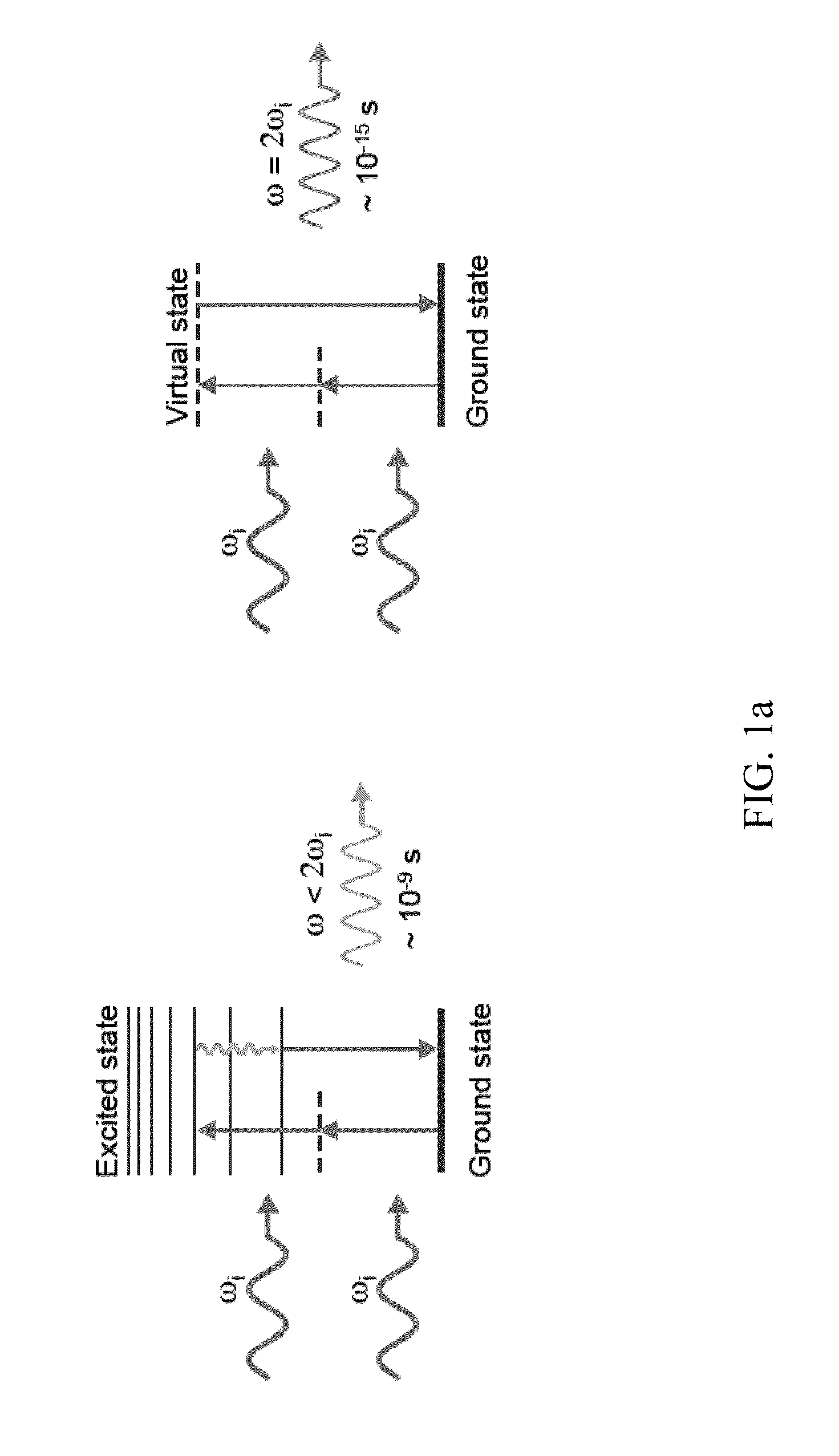Multipurpose analysis using second harmonic generating nanoprobes
a nanoprobe and second harmonic technology, applied in material analysis, biochemistry apparatus and processes, instruments, etc., can solve the problems of increasing the size of the device, the difficulty of identifying cells or probe molecules, and the mechanism and dynamics of biological processes, so as to improve the electric field
- Summary
- Abstract
- Description
- Claims
- Application Information
AI Technical Summary
Benefits of technology
Problems solved by technology
Method used
Image
Examples
example 1
SHG Nanoprobe Emission Profiling
[0055]FIGS. 1b to 1d provide exemplary data graph for a second harmonic emission profile generated from BaTiO3-nanocrystals in accordance with the current invention, and in comparison to the emission characteristics of conventional. Quantum Dots (QD) (d). As shown, the second harmonic emission ranges from 380 to 485 nm displaying, unlike many other optical probes, discrete emission peaks of around 10 nm, and was generated by conventional two-photon excitation, where the excitation energy ranges from 760 to 970 nm.
[0056]For this data (spectrum, blinking property comparison, and signal saturation comparison) SHG nanomaterial solutions were ultrasonicated, nanofiltered and immobilized in 20% polyacrylamide gel. The spectrum was analyzed with the Meta detector of the Zeiss 510NLO microscope setup. For the blinking property comparison between BaTiO3 and water-soluble QD, both immobilized nanomaterials were imaged 300 times (20 frames / second) using a 40× / 1....
example 2
SHG Nanoprobe Imaging
[0062]To test whether SHG nanoprobes can be detected in live vertebrate tissue, BaTiO3 nanoparticles were injected into one-cell stage zebrafish embryos and imaged. More specifically, in this example the SHG nanocrystal probes of the current invention, BaTiO3 nanocrystals were injected into zebrafish embryos. Several days after cytoplasmic injection (around 72 hpf) excitation of nanocrystals with femtosecond pulsed 820 nm light results in strong SHG signal detectable in epi-direction as well as in trans-direction throughout the whole zebrafish body.
[0063]The injected embryos developed indistinguishably from their uninjected counterparts, demonstrating that barium titanate is physiologically inert and non-toxic to the sensitive zebrafish embryonic cells. Bright signal could be detected superficially and deep within the tissue. Even in deep tissues and organs, the imaging required only low levels of illumination intensity. The in vivo SHG intensity spectra were id...
example 3
Field Resonance Enhanced Second Harmonic Technique
[0066]In addition to simple second harmonic imaging using the second harmonic generating nanoprobes of the current invention, the nanoprobes may also be used in a field resonance enhanced mode to allow access to a number of biological processes that can occur below the nanosecond time frame. Using this field resonance enhanced second harmonic (FRESH) technique in accordance with the current invention it is possible to examine the dynamics of biological processes with high sensitivity and spatiotemporal resolution.
[0067]To understand the potential importance of the FRESH technique it is necessary to examine the inner workings of most biological processes. Besides having highly complex three-dimensional. (3D) structures spanning a large range of length scales, living organisms by their nature are very dynamic: molecular processes such as protein, DNA, and RNA conformations—that take place in a timescale ranging from 100 fs to 100 s whi...
PUM
| Property | Measurement | Unit |
|---|---|---|
| excitation wavelength | aaaaa | aaaaa |
| excitation wavelength | aaaaa | aaaaa |
| excitation wavelengths | aaaaa | aaaaa |
Abstract
Description
Claims
Application Information
 Login to View More
Login to View More - R&D
- Intellectual Property
- Life Sciences
- Materials
- Tech Scout
- Unparalleled Data Quality
- Higher Quality Content
- 60% Fewer Hallucinations
Browse by: Latest US Patents, China's latest patents, Technical Efficacy Thesaurus, Application Domain, Technology Topic, Popular Technical Reports.
© 2025 PatSnap. All rights reserved.Legal|Privacy policy|Modern Slavery Act Transparency Statement|Sitemap|About US| Contact US: help@patsnap.com



